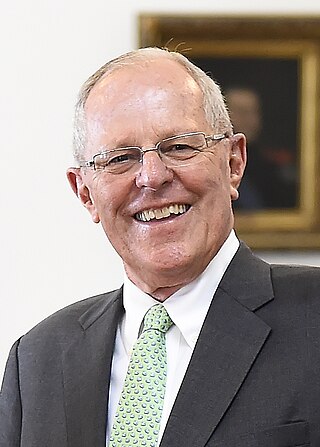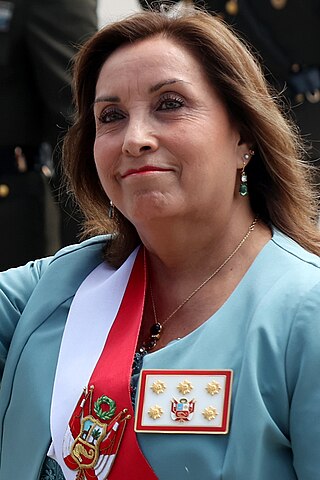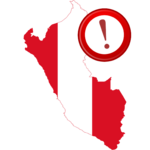Strike
On January 9, the National Commission of Potato Producers announced the start of the strike with quiet protests in several cities of the Peruvian central highlands. After an agreement between farmers and the government, the demonstrations were halted. On January 25, the strikers expected the arrival of government representatives such as the President of the Council of Ministers, Mercedes Aráoz Fernández and the Minister of Agriculture and Irrigation, José Arista. On the agreed day, however, they did not arrive, and representatives of each state organization were sent in their place, and the strikers announced that, as a result, the strike would restart on January 30 but in a violent manner. [4]
On January 30, demonstrators were blocking motorways and burning state installations in all departments, and in this case two deaths and numerous injuries were reported. [5] [6] On February 2 the main stage of the National Commission of Potato Producers reached an agreement with the government to lift the strike. This measure was only made official in the department of Ayacucho and some districts of other departments, this because the other Departmental proceedings are shown to be in disagreement with the ruling. [7] [5] Later in the same month, Ayacucho and other de facto districts would restart unemployment by a strikers majority that did not know what was agreed with the government. [8]
On February 11 the Peruvian government managed to reach an agreement to buy the products exceeded the strikers, both the dissidents and the National Commission of Potato Producers lifted the strike. [9]

The Historic Centre of Lima is the historic city centre of the city of Lima, the capital of Peru. Located in the city's districts of Lima and Rímac, both in the Rímac Valley, it consists of two areas: the first is the Monumental Zone established by the Peruvian government in 1972, and the second one—contained within the first one—is the World Heritage Site established by UNESCO in 1988, whose buildings are marked with the organisation's black-and-white shield.
The Ministry of Agricultural Development and Irrigation is the government ministry in charge of the agricultural sector. As of 7 June 2022, the minister is Andrés Alencastre.

Martín Alberto Vizcarra Cornejo is a Peruvian engineer and politician who served as President of Peru from 2018 to 2020. Vizcarra previously served as Governor of the Department of Moquegua (2011–2014), First Vice President of Peru (2016–2018), Minister of Transport and Communications of Peru (2016–2017), and Ambassador of Peru to Canada (2017–2018), with the latter three during the presidency of Pedro Pablo Kuczynski.

The presidency of Pedro Pablo Kuczynski in Peru began with his inauguration on Peru independence day and ended with the president's resignation following a corruption scandal on March 23, 2018.

The Purple Party is a centrist, liberal and progressive Peruvian political party. The color purple was chosen to represent the blending of red and blue, the colors of left and right-wing parties in Peru, symbolizing the centrist ideology of the party.

Since 2016, Peru has been plagued with political instability and a growing crisis, initially between the President, Pedro Pablo Kuczynski and Congress, led de facto by Keiko Fujimori. The crisis emerged in late 2016 and early 2017 as the polarization of Peruvian politics increased, as well as a growing schism between the executive and legislative branches of government. Fujimori and her Fujimorist supporters would use their control of Congress to obstruct the executive branch of successive governments, resulting with a period of political instability in Peru.
The 2013 Colombian coffee growers strike was a cessation of activities of the Colombian coffee economic sector, carried out with the realization of different mobilizations in several municipalities of the country, and consequently, the blocking of roads and riots between peasants and the Mobile Anti-Disturbance Squadron (ESMAD). The strike began on 25 February 2013, and on 2 March, despite reaching agreements between the government and the representatives of the coffee growers, the strike continued. Finally, on the 8th of the same month, the parties reached an agreement, through which improvements will be recognized to the exercise of coffee growing, and therefore, the end of the strike.

Manuel Arturo Merino de Lama is a Peruvian politician who briefly served as President of Peru for six days between 10 and 15 November 2020. He also served as the President of Congress from 16 March 2020 to 15 November 2020. He was a Member of Congress (AP) representing the Tumbes constituency for the 2001–2006, 2011–2016, and 2020–2021 terms.

The 2020 Peruvian protests were a series of demonstrations sparked after the removal of President Martín Vizcarra that took place from 9 November to 17 November 2020.

Luis Alberto Otárola Peñaranda is a Peruvian attorney and politician who was the Prime Minister of Peru from 2022 until his resignation in 2024. He previously served as Minister of Defense twice, under Ollanta Humala and Dina Boluarte.

Dina Ercilia Boluarte Zegarra is a Peruvian politician, civil servant, and lawyer currently serving as the President of Peru since 7 December 2022. She had served as the first vice president and minister at the Ministry of Development and Social Inclusion under President Pedro Castillo. She served as an officer at the National Registry of Identification and Civil Status (RENIEC) from 2007 until 2022.

On July 23, 2021, following Pedro Castillo's electoral victory, mining communities near Las Bambas copper mine blocked the road used to transport the copper. The protesters claimed that local communities saw little benefit from the wealth generated by the mining.

Mass protests in Peru against inflation and President Pedro Castillo's government began in March 2022. The protests occurred amid rising fertilizer and fuel prices caused by Russia's invasion of Ukraine and international sanctions imposed on Russia. Some of the larger protests were organized by Geovani Rafael Diez Villegas, the leader of the Union of Multimodal Transport Guilds of Peru (UGTRANM) who had previously collaborated in late 2021 with business executives and right-wing politicians, opposing the Castillo government and whose power is recognized as rivaling the government's own Ministry of Transport and Communications. Diez Villegas demanded the removal of passenger restrictions on buses, pardons for transportation workers who were charged with crimes, and negotiations for forgiving debt owed by transportation businessmen to the government. He later organized a general strike aimed at paralysing transportation in Peru beginning on 4 April 2022 that resulted in protests, product shortages, transportation stoppages and rioting.

The Bolivian–Peruvian territorial dispute was a territorial dispute between Bolivia and Peru that lasted from the former's independence in 1825 to the signing of the Polo–Bustamante Treaty in 1909.
Édgar de Jesús Ospina Echeverri is a Colombian football manager.

Following the ousting of president of Peru, Pedro Castillo on 7 December 2022, a series of political protests against the legitimate government of president Dina Boluarte and the Congress of Peru occurred. The demonstrations lack centralized leadership and originated primarily among grassroots movements and social organizations on the left to far-left, as well as indigenous communities, who feel politically disenfranchised. Castillo was removed from office and arrested after announcing the ilegal dissolution of Congress, the intervention of the state apparatus, and the forced establishment of an "emergency government", which was characterized as a self-coup attempt by all government institutions, all professional institutions, and mainstream media in Peru while Castillo's supporters said that Congress attempted to overthrow Castillo. Castillo's successor Dina Boluarte, along with Congress, were widely disapproved, with the two receiving the lowest approval ratings among public offices in the Americas. Among the main demands of the demonstrators are the dissolution of Congress, the resignation of Boluarte, new general elections, the release of Castillo, and the formation of a constituent assembly to draft a new constitution. It has also been reported that some of the protesters have declared an insurgency in Punos's region. Analysts, businesses, and voters said that immediate elections are necessary to prevent future unrest, although many establishment political parties have little public support.

The 2022–2023 Apurímac protests corresponds to a series of protests and violent confrontations that began on 10 December 2022 in the department of Apurímac in the context of the December 2022 Peruvian protests. The protesters demand the resignation of President Dina Boluarte, the closure of the Congress of the Republic, and new general elections. Unlike the protests in other regions and cities, in Apurímac the confrontations are more violent, and criminal acts have been recorded, such as the kidnapping of police officers and attacks on police stations. The Boluarte government declared a state of emergency, removing some constitutional protections from citizens, including the rights preventing troops from staying within private homes and buildings, freedom of movement, freedom of assembly and "personal freedom and security".

The Ayacucho massacre was a massacre perpetrated by the Peruvian Army on 15 December 2022 in Ayacucho, Peru during the 2022–2023 Peruvian protests, occurring one day after President Dina Boluarte, with the support of right-wing parties in Congress, granted the Peruvian Armed Forces expanded powers and the ability to respond to demonstrations. The clash occurred due to the protesters' attempt to storm the local airport. On that day, demonstrations took place in Ayacucho and the situation intensified when the military deployed helicopters to fire at protesters, who later tried to take over the city's airport, which was defended by the Peruvian Army and the National Police of Peru. Troops responded by firing live ammunition at protesters, resulting in ten dead and 61 injured. Among the injured, 90% had gunshot wounds, while those killed were shot in the head or torso. Nine of the ten killed had wounds consistent with the ammunition used in the IMI Galil service rifle used by the army.

On 9 January 2023, Peruvian National Police shot at protesters in Juliaca during the 2022–2023 Peruvian political protests against President Dina Boluarte, resulting in a massacre. At least 18 people, including a medic responding to the scene, were killed and over 100 others were injured by police responding to protests in the city, with all of the deaths being attributed to gunshot wounds. The massacre was the deadliest day during the series of protests in Peru. Local media criticized the response of national media, saying that events in Juliaca were overlooked. The Inter-American Commission on Human Rights would describe the event, along with the similar killings in Ayacucho, as a massacre.
This is a broad timeline of the ongoing 2022–2023 Peruvian protests against the government of Dina Boluarte and the Congress of Peru, sparked by the self-coup attempt of President Pedro Castillo, who was later arrested for his actions. The protests were organized by social organizations and indigenous peoples who felt they experienced political disenfranchisement, specifically on the politically left-wing to far left, with the groups demanding immediate general elections and a constituent assembly to draft a new Constitution of Peru.















